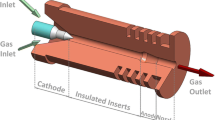Abstract
Modeling results are presented to compare the characteristics of laminar and turbulent argon thermal plasma jets issuing into ambient air. The combined-diffusion-coefficient method and the turbulence-enhanced combined-diffusion-coefficient method are employed to treat the diffusion of ambient air into the laminar and turbulent argon plasma jects, respectively. It is shown that since only the molecular diffusion mechanism is involved in the laminar plasma jet, the mass flow rate of ambient air entrained into the laminar plasma jet is comparatively small and less dependent on the jet inlet velocity. On the other hand, since turbulent transport mechanism is dominant in the turbulent plasma jet, the entrainment rate of ambient air into the turbulent plasma jet is about one order of magnitude larger and almost directly proportional to the jet inlet velocity. As a result, the characteristics of laminar plasma jets are quite different from those of turbulent plasma jets. The length of the high-temperature region of the laminar plasma jet is much longer and increases notably with increasing jet inlet velocity or inlet temperature, while the length of the high-temperature region of the turbulent plasma jet is short and less influenced by the jet inlet velocity or inlet temperature. The predicted results are reasonably consistent with available experimental observation by using a DC arc plasma torch at arc currents 80–250 A and argon flow rates (1.8–7.0)×10−4 kg/s.
Similar content being viewed by others
References
Pfender E (1999). Plasma Chem Plasma Process 19:1
Fauchais P (2004). J Phys D: Appl Phys 37:R86
McKelliget J, Szekely J, Vardelle M, Fauchais P (1982). Plasma Chem Plasma Process 2:317
Chyou YP, Pfender E (1989). Plasma Chem Plasma Process 9:291
Pfender E, Fincke J, Spores E (1991). Plasma Chem Plasma Process 11:529
Murphy AB, Kovitya P (1993) J. Appl Phys 73: 4759
Fincke JR, Chang CH, Swank WD, Haggard DC (1994). Int J Heat Mass Transfer 37:1673
Bauchire JM, Gonzalez JJ, Gleizes A (1997). Plasma Chem Plasma Process 17:409
Vardelle A, Fauchais P, Dussoubs B, Themelis NJ (1998). Plasma Chem Plasma Process 18:551
Li H-P, Chen Xi (2002). Plasma Chem Plasma Process 22:27
Ramachandran K, Nishiyama H (2002). J Phys D: Appl. Phys. 35:307
Fincke JR, Crawford DM, Snyder SC, Swank WD, Haggard DC, Williamson RL (2003). Int J Heat Mass Transfer 46:4201
Williamson RL, Fincke JR, Crawford DM, Snyder SC, Swank WD, Haggard DC (2003). Int. J. Heat Mass Transfer 46:4215
Cheng K, Chen Xi (2004). Int J. Heat. Mass. Transfer. 47:5139
Kuz’min VI, Solonenko OP, Zhukov MF (1995) In Proc. 8th National Thermal Apray Conf., Sept. 11–15, 1995, Houston, pp. 83–88
Osaki K, Fukumasa O, Kobayashi A (2000). Vacuum 59:47
Pan WX, Zhang WH, Zhang WH, Wu CK (2001). Plasma Chem Plasma Process 21:23
Pan WX, Ma W, Wu CK (2002). Plasma Chem Plasma Process 22:271
Pan WX, Ma W, Wu CK (2001) In Zhou YC et al (eds) Mechanics and material engineering for science and experiments. Science Press, Beijing, pp. 427–431
Pan WX, Meng X, Li G, Fei QX, Wu CK (2005). Surf Coat Technol 197:345
Pan WX, Meng X, Chen Xi, Wu CK (2006). Plasma Chem Plasma Process 26:(submitted)
Xu D-Y, Chen Xi, Cheng K (2003). J Phys D: Appl Phys 36:1583
Cheng K, Chen Xi (2004). J Phys D: Appl Phys 37:2385
Xu D-Y, Chen Xi, Pan WX (2005). Int J Heat Mass Transfer 48:3253
Xu D-Y, Chen Xi (2005). Int Commun Heat Mass Transfer. 32:939
Pan WX, Li G, Meng X, Ma W, Wu CK (2005). Pure Appl Chem 77:373
Murphy AB (1993). Phys Rev E 48:3594
Murphy AB (1995). Plasma Chem Plasma Process 15:279
Murphy AB (1996). J Phys D: Appl Phys 29:1922
Patankar SV (1980). Numerical heat transfer and fluid flow. Hemisphere, Washington, pp. 115–146
Schlichting H (1979). Boundary layer theory, 7th edn. McGraw-Hill, New York, pp. 230–234
Loitsyanski LG (1963). Laminar boundary layer. Physico-Mathematic Literature, Moscow, pp. 167–172 (in Russian)
Ricou F, Spalding DB (1961). J Fluid Mech 11:21
Author information
Authors and Affiliations
Corresponding author
Rights and permissions
About this article
Cite this article
Cheng, K., Chen, X. & Pan, W. Comparison of Laminar and Turbulent Thermal Plasma Jet Characteristics—A Modeling Study. Plasma Chem Plasma Process 26, 211–235 (2006). https://doi.org/10.1007/s11090-006-9006-6
Received:
Accepted:
Published:
Issue Date:
DOI: https://doi.org/10.1007/s11090-006-9006-6



